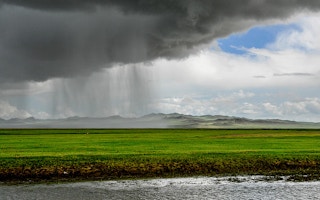Nobel literature laureate and songsmith Bob Dylan certainly got it right: a hard rain is going to fall. As global temperatures rise, extremes of torrential rain will increase accordingly, with the heaviest rainfall up to 15 per cent more intense for every 1°C that the planet warms.
If global temperatures increase by 4°C by the end of the century – and climate studies say they could if the world goes on burning ever greater quantities of fossil fuel and dumping ever higher ratios of greenhouse gases in the atmosphere – then Europe and North America could see the consequences in terms of a 25 per cent increase in extremes of catastrophic precipitation.
Rainfall could become even more extreme in some of the monsoon countries, but in the Mediterranean, Australia and South Africa the rain gauges would measure a less dramatic response, according to a new study in Nature Climate Change journal.
Research such as this is a consequence of the constant drive within science to test its own predictions. Once again, the outcome of the study delivers confirmation.
Rainfall warning
Climate scientists have consistently warned that higher average global temperatures would bring with them greater extremes of heat, rainfall and drought.
They have warned that heatwaves would become more intense, that wildfires will become more frequent, that hot spells could devastate harvests, that extreme droughts could blight the rainforests of the Amazon, and that ominous thunderclouds could increasingly deliver ever greater downpours over the drought-prone Sahel region of Africa.
So the result of a climate model study by a US team from the Massachusetts Institute of Technology (MIT) and researchers from the Swiss Federal Institute of Technology is not just confirmation that with every 1°C rise in temperature, the moisture-carrying capacity of the air rises by 7 per cent – so rain must become heavier.
“
If you’re interested in the impacts of precipitation extremes, you’d want to know what’s happening in your region.
Paul O’Gorman, associate professor, department of Earth, atmosphere and planetary sciences, MIT
It is also an attempt to make estimates of those places likely to feel the rain at its hardest − because governments, regional authorities and communities everywhere need to know what is going to hit them.
“There is interest around the world in the question of whether to adjust codes to adapt to a changing climate and precipitation, particularly for flooding,” says one of the report’s authors, Paul O’Gorman, associate professor in the department of Earth, atmosphere and planetary sciences at MIT.
“We found there are regional variations in the projected precipitation response because of changes in winds, and of course if you’re interested in the impacts of precipitation extremes, you’d want to know what’s happening in your region.”
So the next step was to make sense of where the winds will blow their burden of moisture, and where they are most likely to deposit it, as global temperatures rise.
Global temperatures
The scientists studied the impact of 22 climate model simulations on a world divided into grids of 200km by 100km, and they factored local data in each grid concerning maximum daily rainfall, as well as annual global temperatures.
They ran their models both forwards and backwards in time from 1950 to 2100 – since they had historic data, they could use the past as a test of the future – and all 22 models predicted the greatest increase in rainfall intensity for India and the Equatorial Pacific.
“The observations are telling us there will be increases at almost all latitudes, but if you want to know what’s going to happen at the scale of a continent or smaller, it’s a much more difficult question,” Dr O’Gorman says.
They established that the determining factor in regional variation appeared to be changes in local winds, rather than the burden of water vapour. Storms over the open ocean would be relatively weak, and precipitation over landmasses would be uneven.
The climate zone known as the tropics would expand in both directions, with the subtropics remaining relatively dry in some places, and with extremes of precipitation in others. But the researchers have yet to establish precisely why and where, and what the changes mean for local communities.
“Given an extreme precipitation event, how long does it last − say, in hours − and does that time change with climate warming?” Dr O’Gorman says. “We think the intensity of an event changes, and if the duration also changes, that could be significant too.”
This story was published with permission from Climate News Network.










